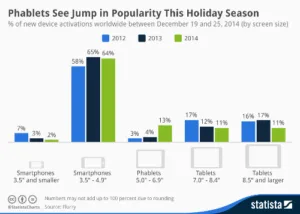According to a statistical analysis by Statista, there was a jump in the popularity of the phablet during the holiday season. Statista looked at new device activations during the holiday season as defined by the time frame between December 19 through to 25.
The result shows that over the last few years the phablet is the only mobile device that shows continued growth. The following chart shows these results from data provided by Flurry.
The numbers are provided for the years 2012 through to 2014 and show that, especially in 2014, the activation of all mobile devices other than phablets declined, even if ever so slightly. The company’s definition of phablets is based on a screen diagonal between 5.0″ and 6.9″. This definition is not the same for all market research firms, so the results from other firms may be slightly different.
The data also shows that smartphones are still the strongest segment among mobile devices with an almost 2/3 market share. Smaller smartphones below 3.5″ make up only 2% of all activations. All tablets (small and large) make up almost one quarter of the activations. However, the tablet activations for all sizes are actually on a downward trend.
Since the activation period is rather short (only one week) we can assume that a large portion of these activations are related to holiday gifts. This also includes gifts to one self rather than to other people.
The activations for the phablet actually increased threefold showing a stronhger interest in this device category. Together with the smaller smartphones they make up almost 80% of all activations, and that’s a strong indication of the continued love affair of the consumer with this mobile device category.
The data also suggests an easy explanation for the declining interest of the tablet regardless of the size. Consumers are opting for a device that can be used as both a smartphone and a tablet at the same time. The tablet in turn is a device that to a certain degree replaces the PC and notebook. As many have argued, the tablet cannot replace the PC and notebook based on the lower processing power and smaller screen size. This argument requires an understanding of what the PC/notebook is being used for by consumers. I would argue that rendering a video is not on top of this list. As it turns out, browsing the web and watching Netflix or YouTube videos is something tablets excel in. At the same time higher resolution mobile displays and younger users allow for watching the content at a much closer distance, wiping away the advantage of the larger screen size of a PC/notebook. When it comes to battery life, the tablet raised the bar pretty high for the notebook especially when we consider the overall weight.
There are many views of consumer behavior circulating among the market analysts, but so far nobody has been able to predict the tablet market development accurately. Maybe there is much more to be learned on why people actually buy tablets and phablets? – Norbert Hildebrand


